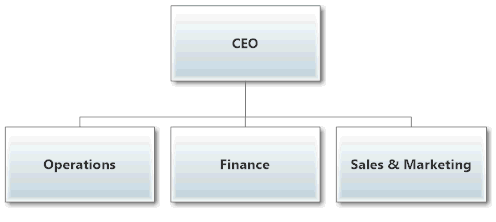Understanding Types of Organizational Structures
One common challenge business leaders face is choosing the most effective organizational structure to help their company thrive.
Why Is Organizational Structure Important?
The organizational structure defines how roles are assigned, how tasks are coordinated, and who reports to whom. Getting this right is essential for clear communication, efficient decision-making, and achieving company goals.
Without a well-designed structure, companies risk:
- Confusing messages between teams
- Poor coordination across functions
- Slow or ineffective decision-making
- Employee frustration and reduced productivity
Choosing the right structure depends on your company’s size, industry, goals, and culture.
Main Types of Organizational Structures
1. Functional Organizational Structure
This is one of the most traditional and widely used structures. The company is divided into departments based on specific functions like marketing, finance, IT, or sales.
- Pros: Highly specialized teams, clear career paths within functions, efficient use of resources.
- Cons: Limited cross-functional communication, risk of silos, narrow perspectives focused only on departmental goals.
Example: A marketing manager leading a dedicated marketing team reporting to a VP who oversees multiple departments.

2. Divisional Organizational Structure
Large organizations operating across different markets or products often use divisional structures. Each division operates as its own unit with responsibility for its resources and results.
- Pros: Greater flexibility, autonomy for divisions, faster decision-making at the division level.
- Cons: Duplication of resources, challenges in sharing knowledge across divisions, potential conflict of priorities.
Divisions can be structured by product lines, geography, or customer segments.
Example: A multinational company with separate divisions for Europe, Asia, and North America regions.

3. Matrix Organizational Structure
This hybrid combines elements of functional and divisional structures. Employees have dual reporting relationships to both functional managers and project or product managers.
- Pros: Enhanced communication across functions, efficient resource use, skill development across projects.
- Cons: Complexity in management and reporting, potential confusion about priorities, conflicts between managers.
Example: An engineer reports to both an engineering manager and a project manager during a product launch.

4. Flat Organizational Structure
This structure has minimal or no middle management layers between staff and executives. It is popular among startups and small businesses.
- Pros: Faster decision-making, increased transparency, greater employee involvement.
- Cons: Possible role confusion, challenges in scaling, overburdened leaders.
Many companies aim to keep their structures as flat as possible to stay agile and responsive to market changes.
Additional Organizational Structures to Consider
5. Team-Based Structure
Teams are formed around specific projects or products, with a focus on collaboration and flexibility.
- Suitable for companies that prioritize innovation and adaptability.
- Encourages ownership and accountability among team members.
6. Network Structure
Organizations outsource many functions and rely on a network of partners, consultants, or freelancers.
- Common in industries where flexibility and expertise are critical, such as media or technology.
Industry-Specific Considerations
Different industries benefit from different structures depending on their pace of change, regulatory environment, and complexity.
- Manufacturing: Often functional or divisional to manage complex operations and supply chains.
- Technology: Frequently matrix or team-based to foster innovation and cross-functional collaboration.
- Retail: Typically divisional by geography or product line for customer-centric focus.
- Startups: Prefer flat structures to maintain agility and fast decision-making.
Best Practices for Choosing Your Organizational Structure
- Define your company goals clearly.
- Assess your company size and growth plans.
- Consider industry norms and competitive environment.
- Focus on communication and collaboration needs.
- Be ready to adapt your structure over time.
Quick Reference: Organizational Structures Comparison Table
| Structure | Ideal For | Advantages | Challenges |
|---|---|---|---|
| Functional | Small to medium companies, specialized roles | Efficiency, expertise development | Siloed departments, limited cross-team communication |
| Divisional | Large companies, multiple products/regions | Autonomy, focus on specific markets | Duplication, inter-divisional competition |
| Matrix | Complex projects, cross-functional work | Flexibility, knowledge sharing | Role confusion, complex reporting |
| Flat | Startups, small teams | Agile decision-making, transparency | Scalability challenges, unclear roles |
Action Plan: Steps to Implement the Right Organizational Structure
- Evaluate your current structure’s strengths and pain points.
- Gather input from leaders and employees on workflow and communication.
- Choose one or a combination of structures that align with your strategic goals.
- Create clear role definitions and reporting lines.
- Communicate the structure changes transparently across the organization.
- Monitor and adjust the structure periodically based on feedback and performance.
Additional Resources to Support Your Organizational Design
To help your business grow and operate efficiently, explore strategic tools such as our comprehensive Small Business Growth Strategy Pack or optimize pricing and profits with the 101 Ways to Optimize Pricing & Profit guide. These resources provide actionable insights to complement your organizational improvements.
Also consider strengthening your team management with the 101 Ways to Attract & Keep Top Talent and improving customer retention using the 101 Ways to Boost Customer Retention & Loyalty.
Implementing the right organizational structure is a foundational step in driving lasting success. Align your teams, clarify roles, and empower employees to collaborate efficiently.






























